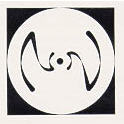 If it weren’t for the steady number of souls searching the spheres for Nucleus Nuance, I’d hesitate to touch this subject. After all, it was a clubby hangout that I never experienced personally so I’m at risk of leaving out things that true-blue fans care about. On the other hand, there doesn’t seem to be much written about the restaurant side of this jazz nightclub, so here goes.
If it weren’t for the steady number of souls searching the spheres for Nucleus Nuance, I’d hesitate to touch this subject. After all, it was a clubby hangout that I never experienced personally so I’m at risk of leaving out things that true-blue fans care about. On the other hand, there doesn’t seem to be much written about the restaurant side of this jazz nightclub, so here goes.
First, why the goofy name? My guess, based on my knowledge of 1960s counterculture, would be it’s not supposed to make sense but, according to Tom Rosenberger who supplied the color photo (with Joni Mitchell’s painting on the wall), the name meant “the center of subtle change.” Regulars shortened it to “the Nucleus” which seems to make a lot of sense for a source of good food and good music.
In 1969 Rudy Marshall, as chef, and Prince Forte, as maitre d’, opened NN at 7267 Melrose Avenue in Los Angeles, serving “subtle savories for the discerning palate.” According to their own account which appeared on the back of a 1983 menu, a couple of years before moving to this location they had operated a “health-conscious cafeteria” which managed to attract regulars such as Howard Hughes. Throughout its tenure, until it closed ca. 1993, the Nucleus remained committed to organic food.
Marshall, once a cook at the Aware Inn, followed the Inn’s moderate approach to healthy cuisine which permitted meat eating. One of the Nucleus’s specialties, “Ra, The Untouchable” (“Prime ground lean steak, mixed with chopped mushrooms, cheddar cheese, black olives, bell peppers and onions”), was reminiscent of the “Swinger,” a burger served at the Aware Inn during Marshall’s stint in the kitchen. It’s likely that “Ra” was kin to an earlier NN incarnation called the “Evolution Burger.”
 In 1979 Nucleus acquired new partners, the Venieros, who introduced fine vintage California wines, hooked up the restaurant with the Garlic Festival, and expanded the premises. Evidently, though, it remained unbeautiful. According to the Los Angeles Times in 1976, the dining room was windowless and “The front door leads you down a long corridor that makes you think you’ve walked in the back door by mistake.” In 1988 it sounded pretty much the same. A review by Alan Richman describes the entrance as “a nightmare, a series of twists and turns along a gloomy cinder-block passageway,” adding that the uninviting exterior was “white cinder-block, the front door solid black, the overhead awning worn out.” (He liked the place once he got settled.)
In 1979 Nucleus acquired new partners, the Venieros, who introduced fine vintage California wines, hooked up the restaurant with the Garlic Festival, and expanded the premises. Evidently, though, it remained unbeautiful. According to the Los Angeles Times in 1976, the dining room was windowless and “The front door leads you down a long corridor that makes you think you’ve walked in the back door by mistake.” In 1988 it sounded pretty much the same. A review by Alan Richman describes the entrance as “a nightmare, a series of twists and turns along a gloomy cinder-block passageway,” adding that the uninviting exterior was “white cinder-block, the front door solid black, the overhead awning worn out.” (He liked the place once he got settled.)
But face it, jazz clubs are supposed to look like that – and, unlike NN, many of them have horrendous food to boot. Appearances aside, with new partners the Nucleus began to build its reputation as a venue which attracted stars such as Herbie Hancock. Joni Mitchell was frequently seen in the audience and commemorated the Nucleus in paintings.
The menu expanded but kept old favorites such as The Ra, Salmon Soufflé, Delectable Duckling (“with our incomparable papaya-cranberry sauce”), Oak Grove Cheese & Walnut Loaf (vegetarian, with curry sauce), and Lady Jana (carob mousse). In the first edition of The Best of Los Angeles (1984), a guide by France’s Gault Millau team, NN was named as the best place in town for salmon soufflé.
See also: “Eating healthy” and Early vegetarian restaurants
© Jan Whitaker, 2009















 It's great to hear from readers and I take time to answer queries. I can't always find what you are looking for, but I do appreciate getting thank yous no matter what the outcome.
It's great to hear from readers and I take time to answer queries. I can't always find what you are looking for, but I do appreciate getting thank yous no matter what the outcome.


